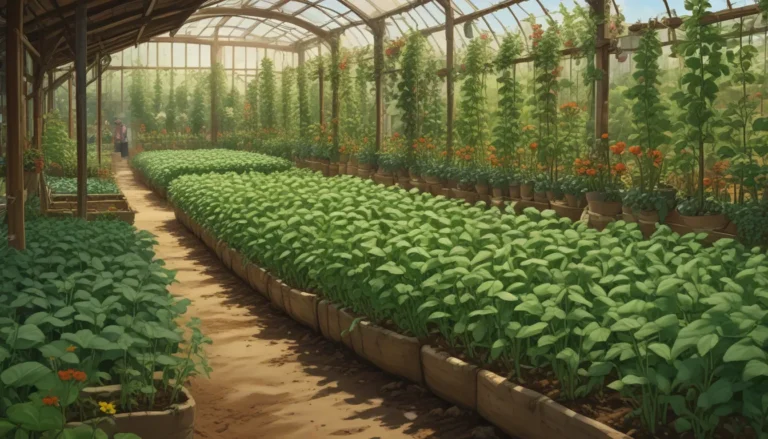The Enchanting World of Sundew Plants: A Complete Guide for Indoor Gardening

Have you ever heard of the intriguing cousin of the Venus flytrap, the sundew plant? While the Venus flytrap captivates us with its dramatic trapping abilities, the sundew quietly entices its prey with sticky sap. In this comprehensive guide, we will explore the magical world of sundew plants, including propagation, growth, and care tips for cultivating these mystical botanical wonders indoors.
Unraveling the Mystery of Sundew Plants
The Droseraceae family, commonly known as sundews, comprises nearly 200 species spread across the globe. These carnivorous plants have evolved in nutrient-deficient environments, such as bogs, marshes, and fens, where they have developed unique adaptations to survive and thrive.
One distinguishing feature of sundews is their trichomes, which cover their leaves and secrete sticky nectar. When unsuspecting insects land on these leaves attracted by the nectar, they become ensnared. The plant then employs thigmonasty, a process where special cells sense movement and cause the leaves to curl around their prey, digesting them with enzymes over a few days.
Sundews feed on a variety of insects, including mosquitoes, gnats, ants, and small bees. Their ability to capture and digest prey makes them fascinating additions to any indoor garden.
Cultivation, History, and Evolution of Sundew Plants
Throughout history, sundews have intrigued botanists and plant enthusiasts alike. Carl Linnaeus and Charles Darwin were among the first to study these plants, recognizing their unique carnivorous capabilities. The early use of sundews in Italian medicine dates back to the 12th century.
Today, sundews are commercially available for indoor cultivation, with various species offering diverse forms, colors, and growth habits. Understanding their evolutionary adaptations and natural habitats can help recreate the perfect growing conditions for these plants.
Propagating Sundews: From Seed to Plantlets
Sundew plants can be propagated through seeds, leaf cuttings, or plantlets. Using a carnivorous plant potting mix and watering with distilled water is essential for successful growth. Seeds are tiny and require consistent moisture to germinate, while leaf cuttings can quickly develop roots in a suitable environment.
Plantlets can be separated from parent plants and potted individually to promote healthy growth. Repotting and dividing plant clusters every few years can ensure optimal conditions for these captivating plants.
Growing Sundews: Tips and Tricks for a Thriving Indoor Garden
To cultivate healthy sundew plants, provide them with direct sunlight for at least six to eight hours each day. Feeding them live insects or fish food pellets ensures they receive essential nutrients. Avoid fertilizers and maintain moist soil with regular watering using distilled water.
Terrariums, glass containers, or natural planters provide suitable environments for growing sundews. Proper soil mix, watering, and feeding schedules are all critical factors for successful growth.
Managing Pests and Disease: Protecting Your Sundews
Sundews are susceptible to pests like aphids and fungus gnats, which can be controlled with natural remedies such as neem oil, cinnamon, or predatory nematodes. Common diseases like Botrytis and root rot can be prevented by maintaining optimal soil moisture levels and proper ventilation.
Regular monitoring and early intervention can help preserve the health and vibrancy of your sundew plants. Taking preventive measures against pests and diseases ensures a thriving indoor garden.
Cultivars and Hybrids: Exploring the Diversity of Sundew Plants
Diverse cultivars and hybrids of sundew plants offer unique characteristics and visual appeal. Varieties like ‘D. capensis ‘Alba’ and ‘D. capensis x spatulata’ showcase different colors and growth patterns, adding a touch of novelty to your indoor garden.
Selecting suitable companion plants like butterwort, bog lily, or Venus flytraps can create a harmonious ecosystem for carnivorous plants to flourish together. Understanding the different species and their requirements can help you cultivate a diverse and vibrant sundew collection.
Best Uses: Embracing the Magic of Sundew Plants
Sundew plants are not only captivating additions to your indoor garden but also serve practical purposes like insect control. Whether potted in containers, terrariums, or combined with other carnivorous plants, sundews add a touch of mystery and charm to any space.
Experimenting with growing sundews indoors, observing their unique trapping mechanisms, and learning about their evolutionary adaptations can be a rewarding and enriching experience for plant enthusiasts.
In closing, cultivating and caring for sundew plants requires attention to detail, understanding their specific needs, and fostering a healthy growing environment. With proper propagation methods, growth tips, and pest management strategies, you can enjoy the beauty and allure of sundew plants in your indoor garden.
Quick Reference Growing Guide
Here’s a handy reference guide summarizing key aspects of growing and caring for sundew plants:
- Plant Type: Carnivorous annual or perennial
- Flower/Foliage Color: Pink, purple, white/chartreuse, green, purple, red
- Native to: Asia, Africa, Australia, Europe, North America, South America
- Maintenance: Moderate-high
- Hardiness (USDA Zone): 3-11
- Tolerance: Wet soil, nutrient deficient soil
- Bloom Time: Varies depending on species
- Soil Type: Sandy
- Exposure: Full sun to partial shade
- Soil pH: 5.0-6.5
- Time to Maturity: 4-6 months
- Soil Drainage: Well-draining
- Spacing: 3 inches or more, depending on species
- Height: 2-36 inches
- Weather: Spring: 60-90°F, Summer: 60-90°F, Fall: 40-60°F, Winter: Varies by species
Sundew plants are not just botanical wonders; they are living marvels that entice us with their mystical charm and captivating beauty. Embracing the magic of sundews in your indoor garden can be a transformative and rewarding experience, offering insights into the fascinating world of carnivorous plants.
So, whether you choose to propagate sundews from seeds or cuttings, grow them in terrariums or glass containers, or experiment with unique cultivars and hybrids, remember to nurture and care for these remarkable plants with love and attention. By fostering an optimal growing environment and following best practices for maintenance and pest control, you can enjoy the enchanting allure of sundew plants in your indoor space. Happy gardening!





